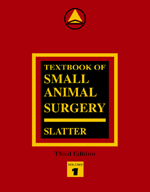|
|
|
| |
 |
|
|

|
 推薦指數:
推薦指數:





|
|
- 內容介紹
|
Textbook Of Small Animal Surgery, 3rd Edition
Douglas Slatter BVSc, PhD, FRCVS, Diplomate, American College of Veterinary Surgeons; Diplomate, American College of Veterinary Ophthalmologists
ISBN 0721686079 · Hardback
Saunders · Published January 2003
This two-volume masterwork offers explicit guidelines for evaluating patients, selecting the right operation, and implementing clinically proven procedures. It covers major topics relevant to the field such as oncology, ophthalmology, dentistry, the nervous system, the urinary and reproductive systems, and more. The up-to-date 3rd edition features an increased emphasis on decision-making algorithms and high-quality images that depict relevant anatomy, diagnostic features, and sequential steps in operative procedures. Expanded, detailed coverage assists the reader with learning and applying the latest surgical techniques.
Features
Contributors from three different continents and 17 countries, outstanding in their fields, lend a global perspective to the work.
Extensive, high-quality illustrations aid the reader in clear visualization of techniques, instrumentation, and diagnosis.
References for each chapter direct the reader to further sources of information.
An appendix of normal laboratory values for the dog and cat put this essential information within easy reach.
A cardiopulmonary resuscitation algorithm is printed on the inside front cover for quick and easy reference.
A quick guide to evaluation and initial stabilization of life-threatening cardiopulmonary complications is printed on the inside back cover for immediate access to crucial information.
What's New
The section on critical care has been expanded to include more complete information.
10 new section editors and 146 new contributors bring new insight to topics in their areas of expertise.
38 new chapters, including a chapter on arthroscopy, reflect current knowledge and advances.
Detailed coverage of surgery techniques present explicit, easy-to-follow guidelines and procedures.
An increased emphasis on decision-making algorithms makes the book even more clinically useful.
Each chapter has been thoroughly revised, providing the most comprehensive scope of coverage for each topic.
|
|
|

